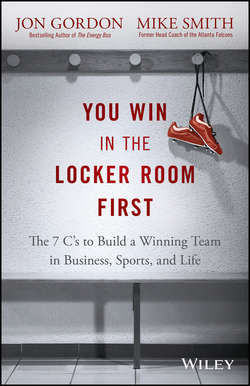Читать книгу You Win in the Locker Room First - Gordon Jon - Страница 11
На сайте Литреса книга снята с продажи.
CHAPTER 1
CULTURE
Know What You Stand For
ОглавлениеJon Gordon
If you are looking to build a new culture or transform the one you have, the first questions you should ask yourself are, “What do we stand for?” and “What do we want to be known for?” For example, for my book The Hard Hat, I interviewed coach Jeff Tambroni, who helped build Cornell lacrosse into a national powerhouse, to ask him how he did it. He said, “We know who our people are. We know who fits our culture.” Jeff built a culture that was defined by a blue-collar work ethic (symbolized by a hard hat), as well as selflessness, teamwork, relentless effort, and continuous improvement. By knowing what their culture stood for, Jeff and his staff were able to choose the right people who fit their culture. When you know what you stand for you can find the right people who stand for the same things as you. Brad Stevens, the head coach of the Boston Celtics, told me that your culture is not just your tradition. It is the people in the locker room who carry it on. When you have people who fit your culture and carry it on, it comes to life in a powerful way.
Knowing what you stand for is just as important in the business world. When Apple was just the two Steves (Steve Jobs and Steve Wozniak), they knew the culture they wanted to create. They wanted to challenge the status quo. Everything they did was influenced by their culture: the people they hired, the products they created, and the campaigns they ran. This approach still influences everything at Apple. Apple is famous for saying that culture beats strategy. What you stand for drives everything else.
I had the opportunity to speak to Southwest Airlines a few years ago, and they told me how consultants suggested they charge passengers to check luggage since the competition was doing it and they could make millions of dollars in additional revenue. Southwest considered their proposal but in the process asked themselves an important question: “Is this what we stand for?” They went straight to their purpose statement: “To connect people to what's important in their lives through friendly, reliable, and low-cost air travel.” They ultimately decided that if they were for everyday fliers and low-cost air travel, they shouldn't charge baggage fees. You would think they would have missed out on a lot of money, but a funny thing happened. Southwest started to get new customers because the airline didn't charge for bags. They ran advertising campaigns highlighting the fact that bags fly free, and they gained market share in the process. Their revenue grew to new heights. It's a great example that once you know what you stand for, decisions are easy to make. Both your strategic decisions and those made on the fly. When your culture dictates your decisions you will enjoy sustained success.
